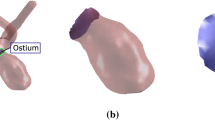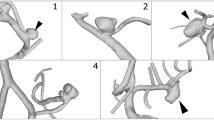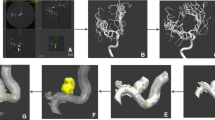Abstract
Background
Morphological irregularity is linked to intracranial aneurysm wall instability and manifests in the lumen shape. Yet there is currently no consent on how to assess shape irregularity. The aims of this work are to quantify irregularity as perceived by clinicians, to break down irregularity into morphological attributes, and to relate these to clinically relevant factors such as rupture status, aneurysm location, and patient age or sex.
Methods
Thirteen clinicians and 26 laypersons assessed 134 aneurysm lumen segmentations in terms of overall perceived irregularity and five different morphological attributes (presence/absence of a rough surface, blebs, lobules, asymmetry, complex geometry of the parent vasculature). We examined rater agreement and compared the ratings with clinical factors by means of regression analysis or binary classification.
Results
Using rank-based aggregation, the irregularity ratings of clinicians and laypersons did not differ statistically. Perceived irregularity showed good agreement with curvature (coefficient of determination R2 = 0.68 ± 0.08) and was modeled very accurately using the five morphological rating attributes plus shape elongation (R2 = 0.95 ± 0.02). In agreement with previous studies, irregularity was associated with aneurysm rupture status (AUC = 0.81 ± 0.08); adding aneurysm location as an explanatory variable increased the AUC to 0.87 ± 0.09. Besides irregularity, perceived asymmetry, presence of blebs or lobules, aneurysm size, non-sphericity, and curvature were linked to rupture. No association was found between morphology and any of patient sex, age, and history of smoking or hypertension. Aneurysm size was linked to morphology.
Conclusions
Irregular lumen shape carries significant information on the aneurysm’s disease status. Irregularity constitutes a continuous parameter that shows a strong association with the rupture status. To improve the objectivity of morphological assessment, we suggest examining shape through six different morphological attributes, which can characterize irregularity accurately.



Similar content being viewed by others
References
Backes D, Rinkel GJE, Greving JP et al (2017) ELAPSS score for prediction of risk of growth of unruptured intracranial aneurysms. Neurology 88(17):1600–1606
Beck J, Rohde S, El Beltagy M, Zimmermann M, Berkefeld J, Seifert V, Raabe A, Mura JM, Rojas-Zalazar D, De Oliveira E (2003) Difference in configuration of ruptured and unruptured intracranial aneurysms determined by biplanar digital subtraction angiography. Acta Neurochir 145(10):861–865
Berkowitz BM (2016) Development of metrics to describe cerebral aneurysm morphology. University of Iowa
Bijlenga P, Ebeling C, Jaegersberg M et al (2013) Risk of rupture of small anterior communicating artery aneurysms is similar to posterior circulation aneurysms. Stroke 44(11):3018–3026
Bisbal J, Engelbrecht G, Villa-Uriol MC, Frangi AF (2011) Prediction of cerebral aneurysm rupture using hemodynamic, morphologic and clinical features: a data mining approach. Lect Notes Comput Sci (including Subser Lect Notes Artif Intell Lect Notes Bioinformatics) 6861 LNCS(PART 2):59–73
Bogunović H, Pozo JM, Villa-Uriol MC, Majoie CBLM, van den Berg R, Gratama van Andel HAF, Macho JM, Blasco J, San Román L, Frangi AF (2010) Automated segmentation of cerebral vasculature with aneurysms in 3DRA and TOF-MRA using geodesic active regions: an evaluation study. Med Phys 38(1):210–222
Cebral J, Ollikainen E, Chung BJ, Mut F, Sippola V, Jahromi BR, Tulamo R, Hernesniemi J, Niemelä M, Robertson A, Frösen J (2017) Flow conditions in the intracranial aneurysm lumen are associated with inflammation and degenerative changes of the aneurysm wall. Am J Neuroradiol 38(1):119–126.
Detmer FJ, Chung BJ, Mut F, Slawski M, Hamzei-Sichani F, Putman C, Jiménez C, Cebral JR (2018) Development and internal validation of an aneurysm rupture probability model based on patient characteristics and aneurysm location, morphology, and hemodynamics. Int J Comput Assist Radiol Surg. https://doi.org/10.1007/s11548-018-1837-0
Dhar S, Tremmel M, Mocco J, Kim M, Yamamoto J, Siddiqui AH, Hopkins LN, Meng H (2008) Morphology parameters for intracranial aneurysm rupture risk assessment. Neurosurgery 63(2):185–196
Etminan N, Brown RD, Beseoglu K, et al (2015) The unruptured intracranial aneurysm treatment score. Neurology 85(10):881–889
Forbes G, Fox AJ, Huston III J, Wiebers DO, Torner J (1996) Interobserver variability in angiographic measurement and morphologic characterization of intracranial aneurysms: a report from the International Study of Unruptured Intracranial Aneurysms
Frösen J, Tulamo R, Paetau A, Laaksamo E, Korja M, Laakso A, Niemelä M, Hernesniemi J (2012) Saccular intracranial aneurysm: pathology and mechanisms. Acta Neuropathol 123(6):773–786
Juchler N, Schilling S, Glüge S, Bijlenga P, Rüfenacht D, Kurtcuoglu V, Hirsch S (2020) Radiomics approach to quantify shape irregularity from crowd-based qualitative assessment of intracranial aneurysms. Computer Methods in Biomechanics and Biomedical Engineering: Imaging and Visualization. https://doi.org/10.1080/21681163.2020.1728579
Juvela S, Porras M, Poussa K (2000) Natural history of unruptured intracranial aneurysms: probability of and risk factors for aneurysm rupture. J Neurosurg 93(3):379–387
Karamanakos PN, Von Und Zu Fraunberg M, Bendel S, Huttunen T, Kurki M, Hernesniemi J, Ronkainen A, Rinne J, Jaaskelainen JE, Koivisto T (2012) Risk factors for three phases of 12-month mortality in 1657 patients from a defined population after acute aneurysmal subarachnoid hemorrhage. World Neurosurg 78(6):631–639
Kleinloog R, De Mul N, Post JA, Rinkel GJE (2017) Risk factors for intracranial aneurysm rupture: a systematic review. Neurosurgery 82(4):431–440
Krings T, Mandell DM, Kiehl TR, Geibprasert S, Tymianski M, Alvarez H, TerBrugge KG, Hans FJ (2011) Intracranial aneurysms: from vessel wall pathology to therapeutic approach. Nat Rev Neurol 7(10):547–559
Larrabide I, Omedas P, Martelli Y, et al (2009) GIMIAS: an open source framework for efficient development of research tools and clinical prototypes. Lect Notes Comput Sci (including Subser Lect Notes Artif Intell Lect Notes Bioinformatics) 5528:417–426
Lauric A, Miller EL, Baharoglu MI, Malek AM (2011) 3D shape analysis of intracranial aneurysms using the writhe number as a discriminant for rupture. Ann Biomed Eng 39(5):1457–1469
Lindgren AE, Koivisto T, Björkman J, von und zu Fraunberg M, Helin K, Jääskeläinen JE, Frösen J (2016) Irregular shape of intracranial aneurysm indicates rupture risk irrespective of size in a population-based cohort. Stroke 47:1219–1226
Liu Q, Jiang P, Jiang Y, Ge H, Li S, Jin H, Li Y (2019) Prediction of aneurysm stability using a machine learning model based on PyRadiomics-derived morphological features. Stroke 50(9):2314–2321
Ma B, Harbaugh RE, Raghavan ML (2004) Three-dimensional geometrical characterization of cerebral aneurysms. Ann Biomed Eng 32(2):264–273
Meng H, Tutino VM, Xiang J, Siddiqui A (2014) High WSS or low WSS? Complex interactions of hemodynamics with intracranial aneurysm initiation, growth, and rupture: toward a unifying hypothesis. Am J Neuroradiol 35(7):1254–1262
Millan RD, Dempere-Marco L, Pozo JM, Cebral JR, Frangi AF (2007) Morphological characterization of intracranial aneurysms using 3-D moment invariants. IEEE Trans Med Imaging 26(9):1270–1282
Morel S, Diagbouga MR, Dupuy N et al (2018) Correlating clinical risk factors and histological features in ruptured and unruptured human intracranial aneurysms: the Swiss AneuX Study. J Neuropathol Exp Neurol 77(7):555–566
Nieuwkamp DJ, Setz LE, Algra A, Linn FH, de Rooij NK, Rinkel GJ (2009) Changes in case fatality of aneurysmal subarachnoid haemorrhage over time, according to age, sex, and region: a meta-analysis. Lancet Neurol 8(7):635–642
Piccinelli M (2012) Characterization of cerebral aneurysm morphology: development of methods and techniques in an open-source framework. Technische Universiteit Eindhoven. https://doi.org/10.6100/IR741500
Raghavan ML, Ma B, Harbaugh RE (2005) Quantified aneurysm shape and rupture risk. J Neurosurg 102(2):355–362
Schneiders JJ, Marquering HA, Van Den Berg R, VanBavel E, Velthuis B, Rinkel GJE, Majoie CB (2014) Rupture-associated changes of cerebral aneurysm geometry: high-resolution 3D imaging before and after rupture. Am J Neuroradiol 35(7):1358–1362
Suh SH, Cloft HJ, Huston J, Han KH, Kallmes DF (2014) Interobserver variability of aneurysm morphology: discrimination of the daughter sac. J Neurointerv Surg 8(1):38–41
Japan Investigators UCAS (2012) The natural course of unruptured cerebral aneurysms in a Japanese cohort. N Engl J Med 366:2474–2482
Vlak MHM, Algra A, Brandenburg R, Rinkel GJE (2011) Prevalence of unruptured intracranial aneurysms, with emphasis on sex, age, comorbidity, country, and time period: a systematic review and meta-analysis. Lancet Neurol 10(7):626–636
Wanke I, Rüfenacht DA (2017) Zufallsbefund intrakranielles Aneurysma. Swiss Medical Forum 17(4):80–82
Wermer MJH, Van Der Schaaf IC, Algra A, Rinkel GJE (2007) Risk of rupture of unruptured intracranial aneurysms in relation to patient and aneurysm characteristics: an updated meta-analysis. Stroke 38(4):1404–1410
Xiang J, Natarajan SK, Tremmel M, Ma D, Mocco J, Hopkins LN, Siddiqui AH, Levy EI, Meng H (2011) Hemodynamic-morphologic discriminants for intracranial aneurysm rupture. Stroke 42(1):144–152
Xiang J, Yu J, Snyder KV, Levy EI, Siddiqui AH, Meng H (2016) Hemodynamic-morphological discriminant models for intracranial aneurysm rupture remain stable with increasing sample size. Journal of Neurointerventional Surgery 8(1):104–110
Acknowledgments
We would like to thank John Bennett for proofreading the manuscript as well as all study participants (in alphabetical order): Jonas Abeken, Sepideh Amin-Hanjani, Hitomi Anzai, Andrea Boraschi, Stefano Buoso, Marco Corniola, Claudia Danzer, Diane de Zélicourt, Felicitas J. Detmer, Michael J. Durka, Guilherme Fideles, Christian F. Freyschlag, Victor Garcia, Manuel Gehlen, Stefan Glüge, David M. Hasan, Nora Huuska, Kartik Jain, Keisuke Kadooka, Eva L. Leemans, Max Lehtinen, Filippo Molica, Manuel Nüesch, Eliisa Netti, Rahul Raj, Sandro Roth, Isabelle Rudolf, Karl Schaller, Andreas Spiegelberg, Vincent Tutino, Isabel Wanke, Kazuhiro Watanabe, Paul Watton, Stephan Wetzel, Karsten H. Wrede, and Erich Zbinden.
Funding
This work was supported by SystemsX.ch, the Swiss initiative in systems biology, under Grant MRD 2014/261 (AneuX project); and by the Swiss National Science Foundation under Grant 147,193 (NCCR Kidney.CH).
Author information
Authors and Affiliations
Corresponding authors
Ethics declarations
Conflict of interest
The authors declare that they have no conflict of interest.
Ethical approval
All procedures performed in studies involving patients were in accordance with the ethical standards of the institutional and/or national research committee and with the 1964 Helsinki declaration and its later amendments or comparable ethical standards. Raw 3D-DRA of the AneuX test data set were provided by the University Hospital of Geneva and collected with formal patient consent according to the @neurIST protocol and ethics authorization PB_2018-00073 (previously CER 07-05) released June 1st 2007 and renewed April 13th 2010, August 19th 2014, and February 28th 2018 initially by the Geneva Cantonal Ethics Commission for Research involving Humans and renewed by Swissethics in 2018.
Additional information
Publisher’s note
Springer Nature remains neutral with regard to jurisdictional claims in published maps and institutional affiliations.
This article is part of the Topical Collection on Vascular Neurosurgery - Aneurysm
Rights and permissions
About this article
Cite this article
Juchler, N., Schilling, S., Bijlenga, P. et al. Shape irregularity of the intracranial aneurysm lumen exhibits diagnostic value. Acta Neurochir 162, 2261–2270 (2020). https://doi.org/10.1007/s00701-020-04428-0
Received:
Accepted:
Published:
Issue Date:
DOI: https://doi.org/10.1007/s00701-020-04428-0




